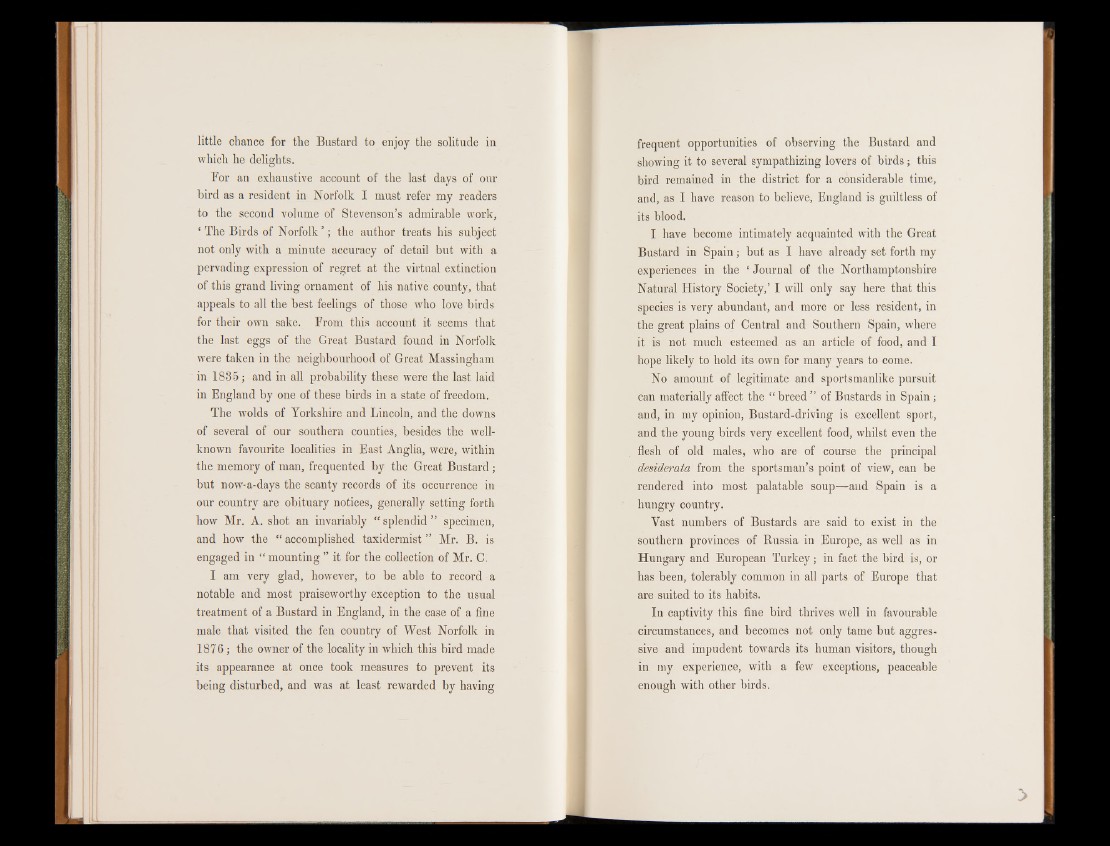
little chance for the Bustard to enjoy the solitude in
which he delights.
For an exhaustive account of the last days of our
bird as a resident in Norfolk I must refer my readers
to the second volume of Stevenson’s admirable work,
‘ The Birds of Norfolk ’i the author treats his subject
not only with a minute accuracy of detail but with a
pervading expression of regret at the virtual extinction
of this grand living ornament of his native county, that
appeals to all the best feelings of those who love birds
for their own sake. From this account it seems that
the last eggs of the Great Bustard found in Norfolk
were taken in the neighbourhood of Great Massingham
in 1835; and in all probability these were the last laid
in England by one of these birds in a state of freedom.
The wolds of Yorkshire and Lincoln, and the downs
of several of our southern counties, besides the well-
known favourite localities in East Anglia, were, within
the memory of man, frequented by the Great Bustard ;
but now-a-days the scanty records of its occurrence in
our country are obituary notices, generally setting forth
how Mr. A. shot an invariably “ splendid ” specimen,
and how the “ accomplished taxidermist ” Mr. B. is
engaged in “ mounting ” it for the collection of Mr. C.
I am very glad, however, to be able to record a
notable and most praiseworthy exception to the usual
treatment of a Bustard in England, in the case of a fine
male that visited the fen country of West Norfolk in
1876; the owner of the locality in which this bird made
its appearance at once took measures to prevent its
being disturbed, and was at least rewarded by having
frequent opportunities of observing the Bustard and
showing it to several sympathizing lovers of birds; this
bird remained in the district for a considerable time,
and, as I have reason to believe, England is guiltless of
its blood.
I have become intimately acquainted with the Great
Bustard in Spain; but as I have already set forth my
experiences in the ‘ Journal of the Northamptonshire
Natural History Society,’ I will only say here that this
species is very abundant, and more or less resident, in
the great plains of Central and Southern Spain, where
it is not much esteemed as an article of food, and I
hope likely to hold its own for many'years to come.
No amount of legitimate and sportsmanlike pursuit
can materially affect the “ breed ” of Bustards in Spain;
and, in my opinion, Bustard-driving is excellent sport,
and the young birds very excellent food, whilst even the
flesh of old males, who are of course the principal
desiderata from the sportsman’s point of view, can be
rendered into most palatable soup—and Spain is a
hungry country.
Vast numbers of Bustards are said to exist in the
southern provinces of Russia in Europe, as well as in
Hungary and European Turkey; in fact the bird is, or
has been, tolerably common in all parts of Europe that
are suited to its habits.
In captivity this fine bird thrives well in favourable
circumstances, and becomes not only tame but aggressive
and impudent towards its human visitors, though
in my experience, with a few exceptions, peaceable
enough with other birds.